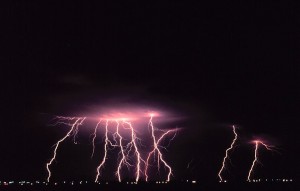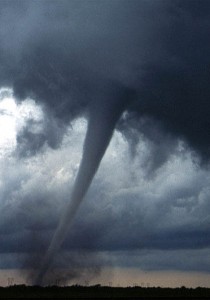Everybody talks about the weather, but nobody does anything about it. ~ Charles Dudley Warner
Today I want to talk a little bit about weather. Right now it is spring in the US. The US is a big country, so spring weather is different for different regions. However, one thing that is common is violent weather, such as thunderstorms and tornadoes.
There are three things that are needed to form a thunderstorm: moisture (humidity), unstable air (meaning that one layer of air is unusually warm, and the other layer of air is unusually cool), and lift (rising air, such as from a weather front, or mountains, or the sea). Since lightning occurs with thunderstorms, we also call them electrical storms. You can estimate how far away a thunderstorm is by counting the seconds between a flash of lightning, and the thunder afterwards. One mile is 5280 feet, and sound travels approximately 1000 feet per second. So if you divide the number of seconds by 5, you will have an estimate of how far away the thunderstorm is, in miles.
If you are outside when a thunderstorm comes, you should get inside a building. Some people have been electrocuted by lightning. Golfers sometimes get hit by lightning because they think that taking shelter under a tree is safe. But lighting often hits the tallest object in the area, so a lone tree on a golf course is a prime target for a lightning strike.
Unstable air is also a cause of tornadoes – a warm air mass, or warm front, collides with a cold mass of air, or cold front. Tornadoes are a spinning column of air, and this spinning comes from something called wind shear. Wind shear happens when the wind changes direction suddenly. When this makes the wind speed increase, the conditions are right for a tornado to form. Many towns have a warning system, such as a loud siren, to alert its residents if a tornado has been spotted in their area. In this case, people should take shelter – preferably in a basement, or at least in an interior room away from windows.
Emergency weather bulletins on radio and TV will alert people of approaching violent weather:
- A severe thunderstorm warning will alert people of a coming thunderstorm, especially one that is particularly violent.
- A tornado watch means that conditions are suitable for the formation of tornadoes, but none have been spotted yet. It may not be necessary for you to take shelter if you are outdoors, but you should keep an eye on the sky and see if the clouds begin to take unusual shape, or start swirling.
- A tornado warning, on the other hand, means that someone has spotted a tornado and notified the authorities. If there is a tornado warning for your area, you should take immediate shelter. Sometimes the tornado appears so suddenly that people only have minutes to take shelter. You should remain in your shelter until the tornado warning has expired, or you hear otherwise that the danger is passed.
Other names for tornadoes are “twister,” “funnel cloud,” and “cyclone.” A tornado that occurs over water is called a “water spout.”
The United States has more tornadoes than any other country in the world. The average is about 1200 tornadoes per year.


